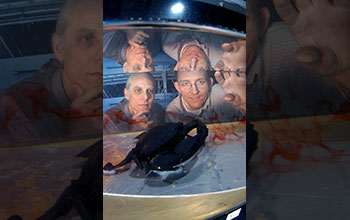Multimedia Gallery
Georgia Tech researchers studying chemical signaling
Georgia Tech researchers Marc Weissburg (left) and Don Webster studied chemical odors in water and the behavioral responses of marine animals to these chemical signals.
More about this Image
Weissburg wants to understand the chemical signals that aquatic animals, such as blue crabs and snails, use to track food and mates from a distance, generally a few meters. He is working in collaboration with Webster, an expert in fluid mechanics. Webster uses a 24-meter, 1,400-gallon flume--essentially an artificial river--to conduct experiments on the turbulent transport of chemical odors through water. Specifically, he investigates the physical mixing mechanisms of the turbulent flow, and quantifies the distribution of the odor filaments. Meanwhile, Weissburg collects information on how animals respond to the chemical signal through behavioral experiments in a smaller flume. They integrate their data to get "the big picture."
To conduct their experiments, Webster injects tiny patches of food odor mixed with a fluorescent dye, which moves downstream and becomes mixed in the flume. Using sophisticated measuring equipment, Webster determines the magnitude of the odor concentration, the size of the odor patches, and changes in the odor concentration as they move through the flume. It is necessary to measure these properties to determine what chemical signals are available to the animals. Through Weissburg's behavioral experiments, the animals can suggest how they are using the signals.
Future application for their research findings includes technology development programs, such as a U.S. Defense Department robotics initiative based on biological design. The hope is that researchers can use their understanding of chemical signaling to design algorithms for devices such as odor-tracking robots. A firmer understanding of how animals collect and use chemical information could help researchers determine how many sensors to place on a robot and where.
This research is supported by the Office of Naval Research and the National Science Foundation (Sensory Systems Program, grant IOS 0321444). (Date of Image: 2003)
Credit: Photo by Gary Meek, courtesy Georgia Tech
Images and other media in the National Science Foundation Multimedia Gallery are available for use in print and electronic material by NSF employees, members of the media, university staff, teachers and the general public. All media in the gallery are intended for personal, educational and nonprofit/non-commercial use only.
Images credited to the National Science Foundation, a federal agency, are in the public domain. The images were created by employees of the United States Government as part of their official duties or prepared by contractors as "works for hire" for NSF. You may freely use NSF-credited images and, at your discretion, credit NSF with a "Courtesy: National Science Foundation" notation.
Additional information about general usage can be found in Conditions.
Also Available:
Download the high-resolution JPG version of the image. (1.6 MB)
Use your mouse to right-click (Mac users may need to Ctrl-click) the link above and choose the option that will save the file or target to your computer.



 All images in this series
All images in this series